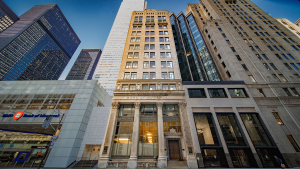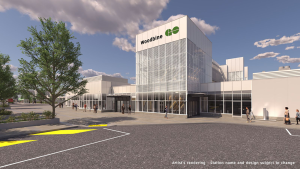In November 2005, audiences in Vancouver and Victoria had the opportunity to hear the eminent timber engineer Julius Natterer present his paper,” A Way To Sustainable Architecture by New Technologies For Engineered Wood Products”. Natterer, the author of definitive texts on wood design and construction and for 25 years professor at the Swiss Federal Institute of Technology, was in Canada at the invitation of BC WoodWORKS! – a program of the Canadian Wood Council whose mandate it is to promote the use of wood in private and public sector projects including those planned for the 2010 Olympics.
The central message of Natterer’s paper is that, in order to maintain and enhance the world’s vital forest cover, we should be using more wood rather than less – in fact, using wood at every opportunity. Natterer points out that in the last 2000 years, the world’s forest cover has been reduced by half – the majority harvested for firewood or cleared for agriculture, patterns that continue to this day in the developing world. Thus the capacity of the world’s ‘lungs’ (trees absorb carbon –based gases and give off oxygen) continues to diminish, while the negative stresses on the atmosphere continue to increase with population, growth and the proliferation of fossil fuel based technology. While Natterer acknowledges the positive effects of energy conservation and fuel alternatives, he believes that greater long term benefits would accrue if equal attention were given to reforestation. Just as several species of big game have been saved from extinction by wildlife management programs funded by hunting licenses, Natterer contends that commercial forestry has a critical role to play in reversing climate change. ‘At this point there is not enough political will to make things happen, and setting aside existing forests exclusively for tourism does not get to the heart of the matter.”
Accordingly, Natterer has spent the last ten years promoting the three ideas that are now drawn together in his paper. These ideas are all based firmly on the premise that the wood we use must be from managed forests where the annual yield is sustained by replanting or natural regeneration.
First and foremost is the principle that we should be using wood in a simple and massive way in all small and medium scale structures. Natterer has pioneered the reintroduction of ‘stacked plank’ systems, solid wall and floor elements built up from sawn lumber naled side by side on edge. These elements are now prefabricated, but the end result resembles the floors of our early warehouse buildings, or the walls of grain elevators. This technique (historically used for structures up to eight storeys in Height) has been applied successfully by Natterer in a variety of residential and commercial projects.. In addition to binding in carbon monoxide (a critical environmental benefit) these solid structures are self finished, acoustically superior to frame construction, and can achieve the necessary fire resistance for all but the most hazardous uses. Their mass contributes to the thermal flywheel effect – the absorption and re-radiation of excess heat that helps regulate diurnal temperature variations in buildings. BC based architect Florian mauerer working with Italian architect Heinrich Zoeschg, recently completed a kindergarten in Lana, Italy which incorporates a stacked plank roof structure, as well as prefabricated roof panels and a glulam curtain wall system.
Second, is the principle that we should be using wood wherever possible, and combining it with other materials according to their optimal performance characteristics. Thus in a multi-storey, multi-family residential situation Natterer will use a composite wood and concrete floor system to deal with issues of odour transfer and water tightness between units. Alternatively, composite floors and solid wood walls might be used within a building whose main structural frame is concrete or steel. These hybrid structures are becoming more common in Europe and have begun to appear in North America in projects such as the four storey Belmont Lofts apartment building in Portland, Oregon by Holst Architecture, where glulam and heavy timber suspended floors span between steel stud exterior walls.
Finally, Natterer advocates the judicious use of engineered wood products such as glulam in structures whose span and loading requirements dictate higher strength and performance. From an environmental standpoint, engineered wood is less beneficial than sawn timber because of the energy it embodies as a result of the drying and gluing process, and the transportation to site from what are typically centralized manufacturing facilities. Nonetheless, for stadiums, convention centres and other long span structures, engineered wood in combination with stacked plank decking and cladding elements remains the best environmental choice. Such structures are still a rarity in Canada, although Busby Perkins Will’s Brentwood SkytrainStation in Burnaby BC successfully combines these high and low-tech approaches.
Natterer’s approach also has inherent social and economic benefits as it implies a system of forest management that is both centralized (for the production of high-tech engineered wood products( and decentralized (for the production of low-tech nailed plank systems.) the widespread adoption of these techniques will mean a greater demand for wood, and necessitate an increased yield that must come from reforestation. Natterer believes that we should be planting trees on every available piece of land however small, and developing localized management systems at an appropriate scale.
Natterer,whose theoretical work is backed by a long list of precedent-setting projects is concerned by the disconnect between intention and implementation that seems to plague major construction projects across the world. Quoting Einstein, still appropriate half a century later, he says, “We live in an age that is characterized by a perfection of means and a confusion of goals.” In Natterer’s view, we have the science and technology to overcome our problems through ‘constructive environmentalism’, but our leaders continue to be distracted by politics and self-interest.
As we confront what he refers to as ‘an environmental High Noon”, we must all work to ensure that our political and corporate gunslingers regain their focus, face up to the real enemy and don’t shoot us all in the foot.










Recent Comments
comments for this post are closed